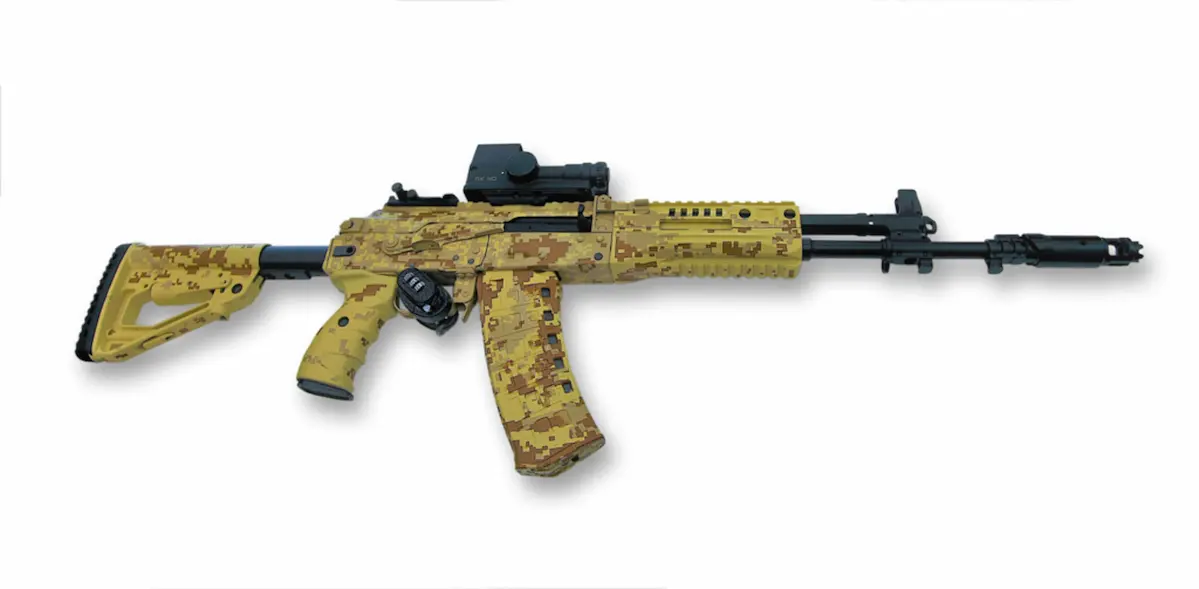
Russia’s AK-12 assault rifle, the latest evolution of the iconic Kalashnikov lineage, brings cutting-edge upgrades in accuracy, ergonomics, and modularity.
Engineering Evolution: From AK-47 to AK-12
The AK-12, officially designated as “Avtomat Kalashnikova 2012,” represents the fifth generation of Kalashnikov rifles. Developed by Kalashnikov Concern, it was designed to replace aging AK-74M rifles and meet the demands of 21st-century warfare. The rifle’s development began in 2011, with the finalized model entering service in 2018 and receiving further upgrades in 2023.
Unlike its predecessors, the AK-12 is built with modularity and ergonomics in mind. It features:
- A redesigned receiver with a Picatinny rail system for mounting optics, lasers, and tactical accessories
- An adjustable telescopic stock with a cheek rest for improved shooter comfort
- A new diopter rear sight for better accuracy in varied lighting conditions
- Ambidextrous fire selector with three modes: safe, three-round burst, and full-auto (single-shot mode removed in the latest version)
The rifle is chambered primarily in 5.45×39mm, but variants exist for 5.56×45mm NATO and 7.62×39mm, making it adaptable for export and special operations.
Built for Battle: Performance and Tactical Edge
The AK12’s performance upgrades are not just cosmetic, they’re battlefield-proven. Drawing lessons from Russia’s military operations, including in Ukraine, the 2023 version of the AK-12 incorporates feedback from frontline troops.
Key performance specs include:
- Rate of fire: 600-1,000 rounds per minute
- Effective range: Up to 625 meters with a 415 mm barrel
- Weight: 3.3 kg (unloaded), making it lighter and more maneuverable than earlier models
- Magazine capacity: Standard 30-round box, with compatibility for 45-, 60-, and 95-round magazines
The rifle’s gas-operated, long-stroke piston system ensures reliability in harsh environments, a hallmark of the Kalashnikov brand. Its improved recoil management and balanced weight distribution enhance accuracy during sustained fire.
The AK-12 also features a slotted flash suppressor and a reinforced foregrip architecture, allowing for better control during rapid engagements.
Strategic Symbolism: The AK-12’s Role in Modern Warfare
Beyond its technical prowess, the AK-12 carries symbolic weight. It marks Russia’s commitment to modernizing its armed forces and maintaining parity with NATO-standard weaponry. The rifle is now standard issue for Russian infantry and has been deployed in active combat zones, including Syria and Ukraine.
The AK-12’s modularity allows it to serve multiple roles—from standard infantry rifle to designated marksman platform. Its compatibility with night vision and thermal optics makes it suitable for urban warfare and low-light operations.
Variants like the AK-15 (7.62×39mm), AK-19 (5.56×45mm NATO), and AK-308 (7.62×51mm NATO) have been developed to cater to different operational needs and export markets. Compact versions (AK-12C) and light machine gun derivatives (RPK-16) further extend the platform’s versatility.
As global interest in modern assault rifles grows, the AK-12 positions Russia as a serious contender in the international arms market. Its blend of rugged reliability and modern features makes it a compelling choice for militaries seeking a balance between tradition and innovation.
Conclusion:
The AK-12 is more than just a new rifle, it’s a statement of intent. With its battlefield-tested upgrades, ergonomic design, and modular adaptability, it redefines what a modern assault rifle can be. As it becomes the backbone of Russian infantry, the AK-12 stands as both a technological achievement and a symbol of evolving military doctrine.
Stay updated with the latest news on Rapido Updates. Keep yourself updated with The World, India News, Entertainment, Market, Automobile, Gadgets, Sports, and many more